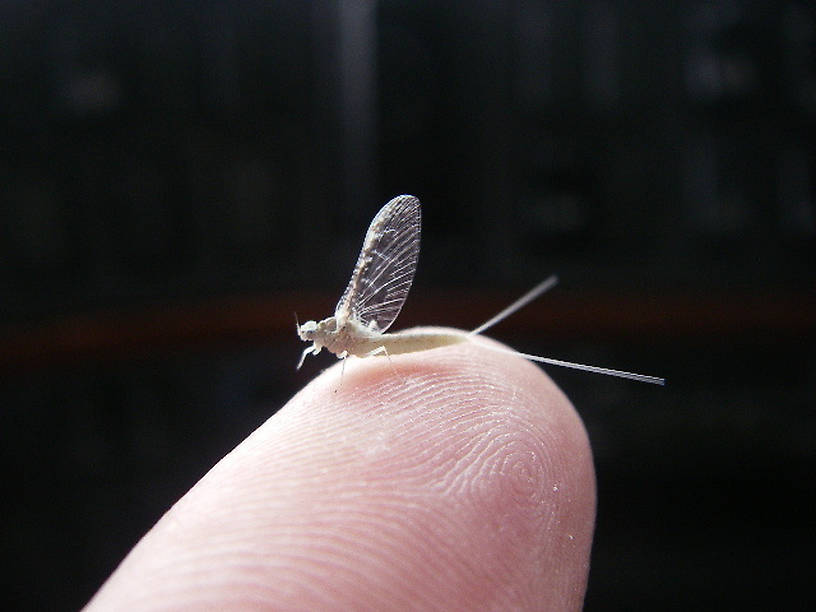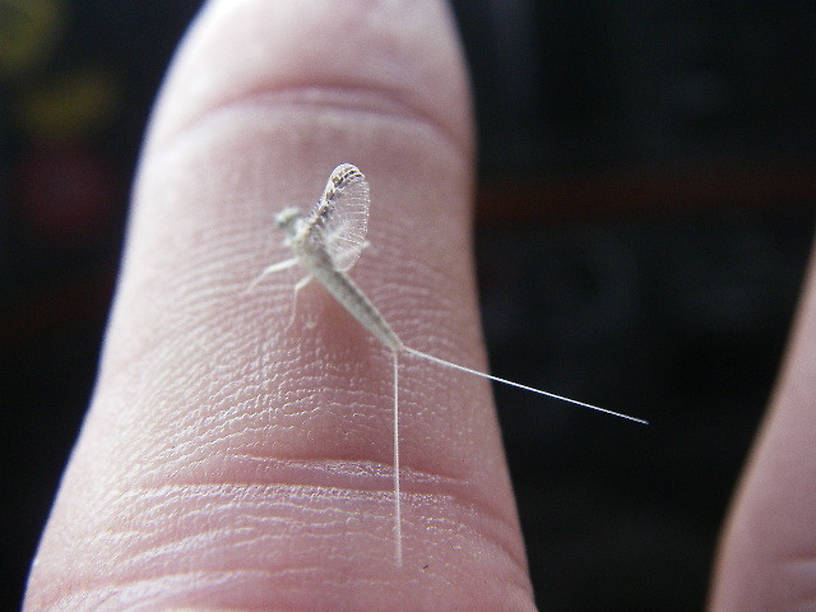Blog & Latest Updates
Fly Fishing Articles
Insects by Common Name


> > Another Unidentified Mayfly
| Calloway | July 24th, 2008, 12:09 pm | |
| Asheville, NC Posts: 5 | Another Mayfly I need to have identified it was found in Fort Royal, VA. Thanks for the help Guys | |
| GONZO | July 24th, 2008, 12:25 pm | |
Site Editor "Bear Swamp," PAPosts: 1681 | This appears to be a female Callibaetis spinner. | |
| Calloway | July 24th, 2008, 8:35 pm | |
| Asheville, NC Posts: 5 | Could it be a cream cahill? | |
| GONZO | July 24th, 2008, 8:58 pm | |
Site Editor "Bear Swamp," PAPosts: 1681 | Well, that would be a good imitation. The pale cross-veins and dark mottling along the leading edge of the wing are Callibaetis traits. The hindwings, although not apparent in the photo, would be quite small. On what is usually thought of as a "cream cahill" (Maccaffertium spp.), dark marking on the wings consists of dark cross-veins, the legs usually have some banding around the middle of the femur, and the hindwings would be larger. (Forewings and legs would probably appear proportionally larger as well.) Callibaetis are usually more common around lakes and ponds, although some streams and rivers have small populations. PS--You can compare your photo to this photo of a female Callibaetis that might be the same species: http://bugguide.net/node/view/129515/bgimage | |
| GONZO | July 24th, 2008, 10:13 pm | |
Site Editor "Bear Swamp," PAPosts: 1681 | Thanks for the additional image, Keith. You can see the sparse, pale cross-veins a bit better in the new photo (top). Notice that the hindwings are so small that they are not apparent in either photo. | |
| Phillyfired | July 25th, 2008, 4:23 pm | |
| Posts: 8 | Gonzo quick question what type of nymph/larva would you recommend to represent the PMD going to 3rd meadow of slough creek next week for 7days need to have everything possible. You have been a great help in learning Thanks Mark A. Pryor Phila Fire Dept. Trk 34 | |
| GONZO | July 25th, 2008, 4:50 pm | |
Site Editor "Bear Swamp," PAPosts: 1681 | Mark, Something Pheasant-Tailish in #16-18 (I'd include some #20s just to be safe) is the usual prescription. Colors could range from light to dark brown, sometimes with either orangish or olive tones. Ephemerellid nymphs often show a fairly broad range of colors, even within the same population of the same species. There are a few little ephemerellids that are referred to as PMDs, but Ephemerella dorothea infrequens (the former Ephemerella infrequens) and Ephemerella excrucians (the former Ephemerella inermis) are the usual suspects. I'm not sure about the timing of these on Slough Creek, but you are probably either in the overlap between them or perhaps favoring excrucians. PS--I just checked my old 1980 Charlton guide. They don't get too scientific about the hatches, but they do mention the "Light Olive Dun" hatch on Slough Creek as a very important hatch from July 15th to September 1st. They might be referring to the excrucians hatch, but I'd include some "Light Olive Duns" in any event. :) | |
| Phillyfired | July 25th, 2008, 8:38 pm | |
| Posts: 8 | Lloyd thanks for the info, will have plenty to bring. Will keep you posted stayed tuned See ya Mark | |
| Phillyfired | July 26th, 2008, 8:59 pm | |
| Posts: 8 | Lloyd somewhere on this site i saw a pheasant-tail nymph right next to a PMD nymph (side by side) i would like to be able to look at them does such a picture exist??? could you help me out with this Thanks Mark A. Pryor PFD Trk 34 | |
| GONZO | July 27th, 2008, 9:06 am | |
Site Editor "Bear Swamp," PAPosts: 1681 | I don't recall that photo, Mark, perhaps someone else will. However, you can get a pretty good idea of what the nymphs look like by looking at the Eastern/Midwestern versions: dorothea http://www.troutnut.com/specimen/766 excrucians http://www.troutnut.com/specimen/588 You can probably find hundreds of versions of the Pheasant Tail nymph on the web. It's hard to beat Sawyer's original, but many tiers don't like tying with copper wire. Or, you could just try this pattern/style: Hook--#16-20 Tails--a few barred partridge fibers Rib--fine gold wire Abdomen/Thorax--rabbit/Antron dubbing blend in yellowish brown, olive brown or dark brown Wingcase--black or dark brown poly yarn over thorax Legs--a few barred partridge fibers on either side of thorax You can weight this nymph with a copper wire underbody (or a bead, I suppose) or use unweighted for fishing in the film. I hope that helps. | |
| Phillyfired | July 27th, 2008, 10:09 am | |
| Posts: 8 | Lloyd Thanks for the info stayed tuned for end results of the 3rd meadow slough creek trip Mark | |
Quick Reply
You have to be logged in to post on the forum. It's this easy:
Related Discussions
| Title | Replies | Last Reply |
| Re: Unknown mayfly? In the Identify This! Board by Braindead | 4 | Aug 9, 2013 by Taxon |
| Re: z-lon or shuck material In Fly Tying by Flytyerinpa | 2 | Jun 9, 2017 by FishMe69 |
| Re: Bead head or not??? In Beginner Help by Gt2003 | 4 | Mar 19, 2019 by Jmd123 |
| Re: Unidentified Baetidae (2 more) In the Identify This! Board by Benthosfan | 8 | May 5, 2021 by Benthosfan |
| Re: can you identify this bug? In the Identify This! Board by Wchougland | 1 | Jan 12, 2021 by Troutnut |
| Re: small nymph In the Identify This! Board by Jonsecrist | 1 | Jan 18, 2011 by Dryfly |
| Re: Family ID for this one? In Isoperla Stonefly Adult by Troutnut | 2 | Jul 30, 2006 by Troutnut |
| Re: Baetid nymph color In Male Baetidae Mayfly Nymph by Martinlf | 1 | Dec 26, 2006 by GONZO |
| Re: Pattern Suggestions In General Discussion by Kschaefer3 | 5 | Mar 1, 2016 by Jmd123 |
| Re: Baetis Nymph, Is this it? In General Discussion by Lastchance | 1 | Mar 10, 2013 by Martinlf |
Troutnut.com is copyright © 2004-2024 Jason
Neuswanger (email Jason). See my FAQ for information about use of my images.
 privacy policy
privacy policy


